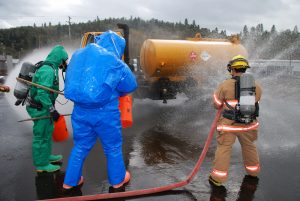The EPA announced a settlement with Par Hawaii Refining LLC on January 19 that included a $176,899 penalty over Emergency Planning and Community Right-to-Know Act (EPCRA) and Clean Air Act (CAA) violations at its oil refining facility in Kapolei, Hawaii.
The company’s EPCRA violations included “failures to immediately notify the state emergency response commission and the local emergency planning committee of releases of sulfur dioxide above the reportable quantity, which occurred on several occasions in 2014 and 2015.” Other violations included “process safety information errors, such as inaccurate piping and machine diagrams. EPA also found several operating procedures that were unclear, not current, and were missing information, in addition to mechanical integrity failures.”
“CERCLA section 109 and EPCRA section 325 also authorize administrative penalties enforced through civil proceedings,” states the EPA website. Per 40 Code of Federal Regulations (CFR) 19.4, the civil monetary penalties in the amount of $62,689 per violation may be assessed for failing to comply with the release reporting requirements under EPCRA or the Comprehensive Environmental Response, Compensation, and Liability Act (CERCLA). With such heavy fines on the line, it’s important for industry to understand the reporting requirements and the regulations.
Defining releases requiring reporting
Spills and release reporting are governed by regulations under the following two statutes:
- EPCRA
- CERCLA
EPCRA
“The Emergency Planning and Community Right-to-Know Act (EPCRA) of 1986 was created to help communities plan for chemical emergencies,” states the EPA EPCRA website. “It also requires industry to report on the storage, use and releases of hazardous substances to federal, state, and local governments.”
EPCRA Section 304 addresses emergency notifications and requires facilities to “immediately report accidental releases of EHSs and ‘hazardous substances’ defined under [CERCLA]. Any releases of these substances in quantities greater than their corresponding Reportable Quantities (RQs) must be reported to state and local officials.” The extremely hazardous substances (EHSs) are listed under 40 CFR 355 Appendices A and B. CERCLA hazardous substances are listed under 40 CFR 302.4.
The emergency release notification must include:
- The chemical name;
- An indication of whether the substance is extremely hazardous;
- An estimate of the quantity released into the environment;
- The time and duration of the release;
- Whether the release occurred into air or water and/or on land;
- Any known or anticipated acute or chronic health risks associated with the emergency and, where necessary, advice regarding medical attention for exposed individuals;
- Proper precautions, such as evacuation or sheltering in place; and
- Name and telephone number of the contact person.
The initial notification to the State Emergency Response Commission (SERC) and Local Emergency Planning Committee (LEPC) must be immediate. The regulation also requires that the facility submit a follow-up written report to the SERC and LEPC as soon as possible after the release. The follow-up report must include updated information on the initial emergency notification, information on the actions taken, and the medical attention required for any people exposed.
Emergency release notifications under EPCRA are not required if the release only results in on-site exposure or is a federally permitted release. In addition, there are other exemptions for specific substances or types of facilities.
To learn more about these requirements, see the EPA Emergency Release Notification regulation document.
CERCLA
Under CERCLA Section 101 (22), a “release” is defined as any ” … spilling, leaking, pumping, pouring, emitting, emptying, discharging, injecting, escaping, leaching, dumping, or disposing into the environment (including the abandonment or discarding of barrels, containers, and other closed receptacles containing any hazardous substance or pollutant or contaminant) …”
The “release” definition includes any occurrence when a hazardous substance enters the environment, whether that is in the air, on land, or in surface or groundwater.
Emergency release notifications under CERCLA are required for all RQ releases of CERCLA hazardous substances. These substances are defined in 40 CFR 302.4
Section 103(a) of CERCLA requires that the person in charge of a vessel or an offshore or onshore facility immediately notify the National Response Center whenever an RQ or more of a CERCLA hazardous substance is released in any 24-hour period, unless the release is federally permitted. The purpose of this requirement is to notify officials of potentially dangerous releases so they can evaluate the need for a response action.
Section 103(a) is modified under Section 103(f)(2) for certain “continuous” and “stable in quantity and rate” releases to allow for less frequent notification requirements.
Preparation
Advance preparation is the best approach for accidental releases. The key tips are:
- Know what substances you have on-site and their RQs.
- Be able to quickly access information on health risks and other information associated with these substances.
- Make sure that appropriate personnel are trained in the emergency release notification procedures and understand which information must be included in the event of a release.

